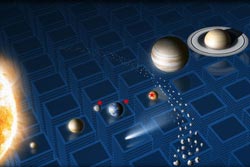NASA Goddard Planetary Instruments Score a Hat Trick

Three mass spectrometers built at Goddard were operating on the same day at the moon, on Mars and en route to Mars. Image Credit: NASA<br>
The instruments, all flying on NASA missions, are mass spectrometers, designed to take in atmospheric, rock or soil samples and identify particular molecules in them. The investigations lined up because of the operating schedules for the three, which must take turns with other instruments on their respective spacecraft.
“At the moon and Mars and part way in between, we had three mass spectrometers happily operating in their other-worldly environments or being checked out for the first time in space on the same day,” said Paul Mahaffy, the principal investigator for the instruments.
Goddard’s Planetary Environments Lab, headed by Mahaffy, built all three instruments. The mass spectrometers identify gases in atmospheric samples or gases that get released from rock or soil samples as they are processed. To pick out individual components in a sample, an electron beam is used to break the large molecules into smaller fragments. Then high-frequency electric fields are applied to the resulting mixture to sort the fragments by mass and electric charge, producing a fingerprint of the molecules present.
Stationed at the moon was NASA’s Lunar Atmosphere and Dust Environment Explorer, or LADEE, which entered an equatorial orbit on Nov. 20 and began science operations the following day. On Dec. 4, the mission’s Neutral Mass Spectrometer was checking out the moon’s thin atmosphere. The instrument will continue to collect samples over multiple orbits with the moon in different space environments.
En route to Mars was NASA’s Mars Atmosphere and Volatile Evolution, or MAVEN, mission. Launched on Nov. 18, the spacecraft is in the early cruise phase and is scheduled to arrive at the Red Planet in September 2014. The mission’s Neutral Gas and Ion Mass Spectrometer was turned on for the first time on Dec. 4 and measured calibration gases in the instrument.
Upon the spacecraft’s arrival at Mars, the instrument will study the planet’s fragile upper atmosphere, examining its composition and determining how quickly some of the gases are escaping into space over time. This information will help scientists understand what the Martian atmosphere looked like billions of years ago and how most of it has been lost since then.
On the surface of Mars was NASA’s Mars Science Laboratory’s Curiosity rover, which carries the Sample Analysis at Mars (SAM) instrument suite. SAM has been analyzing multiple samples of the atmosphere and soils and rocks to help scientists understand how habitable Mars was in the past.
“With these studies, mass spectrometry is helping us piece together the histories of the moon and Mars and offers a vision of their futures,” said Mahaffy. “It’s a perfect example of how invaluable these instruments are for space science.”
MAVEN's principal investigator is based at the University of Colorado Laboratory for Atmospheric and Space Physics in Boulder. Goddard manages the MAVEN mission. NASA’s Jet Propulsion Laboratory, a division of the California Institute of Technology in Pasadena, Calif., built the Curiosity rover and manages the Mars Science Laboratory Project. NASA's Ames Research Center at Moffett Field in California manages the LADEE mission.
By Elizabeth Zubritsky
Media Contact
All latest news from the category: Physics and Astronomy
This area deals with the fundamental laws and building blocks of nature and how they interact, the properties and the behavior of matter, and research into space and time and their structures.
innovations-report provides in-depth reports and articles on subjects such as astrophysics, laser technologies, nuclear, quantum, particle and solid-state physics, nanotechnologies, planetary research and findings (Mars, Venus) and developments related to the Hubble Telescope.
Newest articles

Webb captures top of iconic horsehead nebula in unprecedented detail
NASA’s James Webb Space Telescope has captured the sharpest infrared images to date of a zoomed-in portion of one of the most distinctive objects in our skies, the Horsehead Nebula….

Cost-effective, high-capacity, and cyclable lithium-ion battery cathodes
Charge-recharge cycling of lithium-superrich iron oxide, a cost-effective and high-capacity cathode for new-generation lithium-ion batteries, can be greatly improved by doping with readily available mineral elements. The energy capacity and…

Novel genetic plant regeneration approach
…without the application of phytohormones. Researchers develop a novel plant regeneration approach by modulating the expression of genes that control plant cell differentiation. For ages now, plants have been the…





















